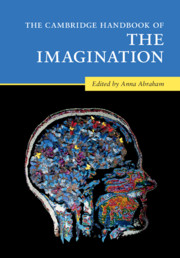Book contents
- The Cambridge Handbook of the Imagination
- The Cambridge Handbook of the Imagination
- Copyright page
- Dedication
- Contents
- Figures
- Contributors
- Acknowledgments
- 1 Surveying the Imagination Landscape
- Part I Theoretical Perspectives on the Imagination
- 2 The Evolution of a Human Imagination
- 3 Material Imagination: An Anthropological Perspective
- 4 The Archaeological Imagination
- 5 Philosophical Perspectives on Imagination in the Western Tradition
- 6 Imagination in Classical India: A Short Introduction
- 7 From Prediction to Imagination
- 8 Memory and Imagination: Perspectives on Constructive Episodic Simulation
- 9 Capturing the Imagination
- 10 A Sociocultural Perspective on Imagination
- 11 Artificial Intelligence and Imagination
- Part II Imagery-Based Forms of the Imagination
- Part III Intentionality-Based Forms of the Imagination
- Part IV Novel Combinatorial Forms of the Imagination
- Part V Phenomenology-Based Forms of the Imagination
- Part VI Altered States of the Imagination
- Name Index
- Subject Index
- References
9 - Capturing the Imagination
from Part I - Theoretical Perspectives on the Imagination
Published online by Cambridge University Press: 26 May 2020
- The Cambridge Handbook of the Imagination
- The Cambridge Handbook of the Imagination
- Copyright page
- Dedication
- Contents
- Figures
- Contributors
- Acknowledgments
- 1 Surveying the Imagination Landscape
- Part I Theoretical Perspectives on the Imagination
- 2 The Evolution of a Human Imagination
- 3 Material Imagination: An Anthropological Perspective
- 4 The Archaeological Imagination
- 5 Philosophical Perspectives on Imagination in the Western Tradition
- 6 Imagination in Classical India: A Short Introduction
- 7 From Prediction to Imagination
- 8 Memory and Imagination: Perspectives on Constructive Episodic Simulation
- 9 Capturing the Imagination
- 10 A Sociocultural Perspective on Imagination
- 11 Artificial Intelligence and Imagination
- Part II Imagery-Based Forms of the Imagination
- Part III Intentionality-Based Forms of the Imagination
- Part IV Novel Combinatorial Forms of the Imagination
- Part V Phenomenology-Based Forms of the Imagination
- Part VI Altered States of the Imagination
- Name Index
- Subject Index
- References
Summary
To paraphrase the famous beginning of Douglas Adams’s The Hitchhiker’s Guide to the Galaxy: “Imagination is big. Really big. You just won’t believe how vastly hugely mindbogglingly big it is.” And it must be important, if even neuroscientists have noticed it. With momentum gathering to get a more comprehensive and interdisciplinary grip on the human imagination, at a time when still no one has much of a clue about this hypercomplex realm of the mind, we can expect to be treated to an initial proliferation of ideas, views, frameworks, and theories on the matter. But that is a good thing. There must be variation before there can be selection. Taking advantage of this temporarily heightened tolerance for speculation, this chapter proposes that the process of navigating an imaginary space can be described by different evolutionary algorithms that vary according to the prior knowledge we have of the topography of the imagined landscape or, put another way, the degree of sightedness we have of the fitness function of the imagined domain. Seen from this perspective, the category “novel combinatorial” of Abraham’s (2016) framework is best dissolved, with creative thinking being distributed and embedded into all other forms of the imagination.
- Type
- Chapter
- Information
- The Cambridge Handbook of the Imagination , pp. 132 - 142Publisher: Cambridge University PressPrint publication year: 2020
References
- 1
- Cited by



